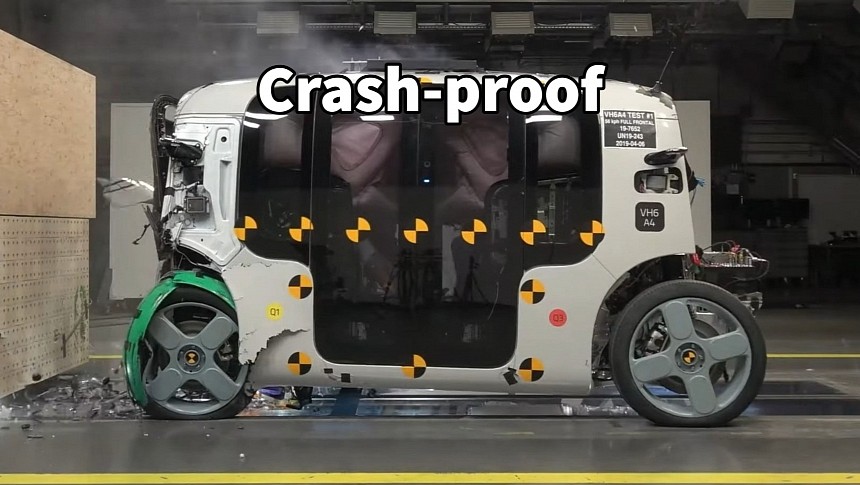People claim that driverless cars could be safer than human drivers, but that doesn't mean autonomous vehicles don't need to offer crash protection to their passengers. Zoox, the self-driving technology company owned by Amazon, offered a rare insight into the safety features of its driverless pod.
Zoox wants to offer robotaxi services using autonomous vehicles without pedals or a steering wheel. The Amazon-owned startup has applied for a permit to test its driverless pods in California. In February, Zoox started its first tests on a one-mile public route between two headquarters office buildings in Foster City, CA. Some would say that the future is already upon us, and the era of safe, affordable personal mobility is nigh. This impression is enhanced as Waymo and Cruise pursue similar goals with their own driverless pods.
Autonomous vehicles promise to offer increased safety, eliminating human error from the equation. This might be true, but driverless cars are still involved in car accidents, even if most are minor. People hope that car crashes will be eliminated when all the vehicles on the roads become autonomous. Until then, present-day robotaxis must still offer its passengers a high level of protection. This is something that Zoox acknowledged when developing its driverless pod.
In a recent video, the robotaxi company shows what safety features it has baked into its cars to protect its passengers in the most severe crashes. The safety design started with computer simulations and culminated with real-life crash tests of the first prototypes. Then the results were used to improve the current generation of Zoox vehicles, which started the process from the beginning.
Zoox robotaxis face unique challenges compared to traditional vehicles because they don't have a "front part" or a dashboard from which to deploy the airbags. Instead, Zoox vehicles seat their passengers on two benches facing each other and can drive in either direction. Thus, Zoox thought of a solution to deploy the airbags from the car's roof.
To offer the same level of protection as traditional cars, Zoox cocoons passengers in airbags that protect them from front and side collisions. It calls it a "horseshoe airbag system," and Zoox claims it offers the highest level of protection for every seat in the robotaxi. This system is supplemented by two frontal airbags for each row of occupants to ensure that all passengers are protected and do not bump into each other in a crash.
Another particularity of its robotaxis is their compact footprint, which doesn't leave much room for crumple zones. Zoox has addressed this by locating the drive units further inside the EV platform. This allows it to absorb much of the impact and disperse the forces before they reach the passenger cell. This approach is unique not only to the robotaxi world, but to the automotive industry as a whole if Zoox's claims hold water.
Autonomous vehicles promise to offer increased safety, eliminating human error from the equation. This might be true, but driverless cars are still involved in car accidents, even if most are minor. People hope that car crashes will be eliminated when all the vehicles on the roads become autonomous. Until then, present-day robotaxis must still offer its passengers a high level of protection. This is something that Zoox acknowledged when developing its driverless pod.
In a recent video, the robotaxi company shows what safety features it has baked into its cars to protect its passengers in the most severe crashes. The safety design started with computer simulations and culminated with real-life crash tests of the first prototypes. Then the results were used to improve the current generation of Zoox vehicles, which started the process from the beginning.
Zoox robotaxis face unique challenges compared to traditional vehicles because they don't have a "front part" or a dashboard from which to deploy the airbags. Instead, Zoox vehicles seat their passengers on two benches facing each other and can drive in either direction. Thus, Zoox thought of a solution to deploy the airbags from the car's roof.
To offer the same level of protection as traditional cars, Zoox cocoons passengers in airbags that protect them from front and side collisions. It calls it a "horseshoe airbag system," and Zoox claims it offers the highest level of protection for every seat in the robotaxi. This system is supplemented by two frontal airbags for each row of occupants to ensure that all passengers are protected and do not bump into each other in a crash.
Another particularity of its robotaxis is their compact footprint, which doesn't leave much room for crumple zones. Zoox has addressed this by locating the drive units further inside the EV platform. This allows it to absorb much of the impact and disperse the forces before they reach the passenger cell. This approach is unique not only to the robotaxi world, but to the automotive industry as a whole if Zoox's claims hold water.








